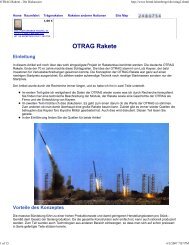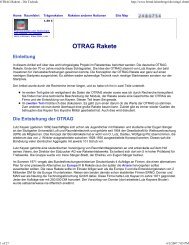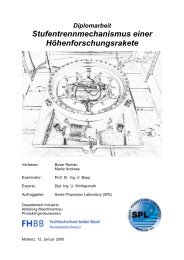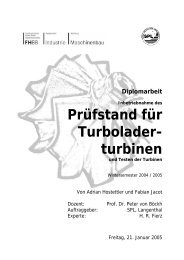Create successful ePaper yourself
Turn your PDF publications into a flip-book with our unique Google optimized e-Paper software.
nozzle throat diameter is variable, it is at least possible that for the upper stages to reduce<br />
and to increase the specific impulse at the expense of thrust. Two former employees of<br />
<strong>OTRAG</strong> confirmed my suspicion. In test flights, according to Kayser's successor, Frank<br />
Wukasch of a specific impulse of 1800 m / s was measured. Taking this for the first and<br />
2100-2200 for the upper levels, then the payload is reduced considerable. The three-stage<br />
design is not possible and a four-stage version is necessary. Even this would be only<br />
about one-fifth of the details of Lutz Kayser. Module for the 256 version I calculate a<br />
maximum payload of 800 kg instead of 4000th Harry O. Ruppe has also calculated the<br />
<strong>OTRAG</strong> rocket with realistic detail and comes to 2900 kg instead of 10000 kg for the<br />
large version. Harry O. Ruppe is no stranger: He was involved at the start of the lunar<br />
probe Pioneer 4, in the implementation of the Apollo project and Director of the Planning<br />
Office for Skylab. From 1966 he established the Department of Aerospace Engineering at<br />
the TUM and was long-time professor and Director of the TUM. This shows that even<br />
professionals get the same results. Harry Ruppe also assumes a maximum specific<br />
impulse of 2286 m / s.<br />
Ruppe sees two other weaknesses in the concept: First, the type of control. The high<br />
pressure of the fuel, the engines react slow, for a large rocket which requires much more<br />
sensitive towards disturbing forces is likely to slow. Ruppe said only after 1 second<br />
would occur if a large rocket a tax effect. In fact, so was the only test in which they<br />
wanted to test this control, a failure because they rocket tipped off and the controller<br />
could not compensate for this.<br />
The second criticism is as claimed by the Corps as the modular concept is not really<br />
scalable. There are geometric constraints complied with in practice will lead to that<br />
individual missiles have always twice the payload of the previous version. If we extend a<br />
rocket to left or right modules, so this only increases the ratio of the mass of the first<br />
stage to second stage. However, this is not the payload is so important. The price of the<br />
rocket increases, but hardly the payload. Intermediate sizes are possible only by partial<br />
filling, corresponding to a specific deterioration of the rocket. The price for the modules<br />
RECOURSE same, only the decrease in fuel costs.<br />
Way, there are still a weakness in <strong>OTRAG</strong> Concept: The size of the graphite ring to the<br />
thrust can be controlled. One thing is clear: Larger nozzle throat area - more thrust. But:<br />
The capacity is always the same and the delivery pressure as well. Thus, the jet velocity<br />
decreases in the same way. The 24 m module but must have more thrust than a 12 m<br />
module. This further worsened the specific impulse. This is most clearly seen in the thrust<br />
coefficient: This is a 10 cm ring at 1.27, worse than any other rocket (typical values 1.4 -<br />
1.9) and already close to that of a firework rocket (1.0 = no nozzle).<br />
Libya<br />
The history of <strong>OTRAG</strong> in Libya is still a puzzling chapter. The official version I've<br />
played. Here again are the short form:<br />
According to Mr Kayser he chose because Libya, the Libyan government is not unlike<br />
many others is blackmail. This conclusion, he moved to the expulsion from Zaire.















